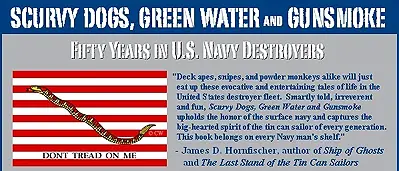 |
 |
|
The USN / USMC Remington Model 870 Shotgun By Bob Cohen and Dave Hood Small-arms comprise those gun-type weapons normally carried and used by infantry personnel and include shoulder-fired rifles, automatic rifles, carbines, pistols, revolvers, machine-guns (up to 0.60 inches in caliber) and shotguns. Although destroyers are designed to conduct combat operations at sea, there has always been a need for infantry weapons to ensure shipboard security. This has become even more important in view of today�s ever-present terrorist threat. While there have been revolutionary developments in most modern naval weapon systems, this is not the case with small-arms. Rather, the U.S. Navy has equipped the fleet with weapons that have steadily evolved into highly effective tools. A gunner�s mate from WWII would find himself quite comfortable with a weapon taken from today�s small-arms locker. A shotgun is a smooth-bore, shoulder-fired weapon. Unlike a rifle, which launches one single projectile at a time, the shotgun instead fires a number of spherical lead pellets with each shot. Shotguns are relatively short-ranged weapons for two reasons: first, unlike the aerodynamic spin-stabilized bullets fired by rifles, the shotgun�s round pellets rapidly slow down and lose energy. Second, as the pellets travel downrange they tend to spread out, so the further away the target is, the fewer pellets will actually strike it. Far from being drawbacks, these unique characteristics of the shotgun make the weapon well suited for shipboard use. At close range, the lethality of the shotgun is unsurpassed and its lack of penetrative ability is a plus when stray shots could cause materiel damage. Shotguns are categorized by their mechanical operating action (pump, semiautomatic or multi-barrel, for instance) and by their �gauge,� or caliber. The gauge nomenclature is an archaic English system whereby the bore�s diameter is described by the number of lead balls of that diameter required to weigh one pound. Thus, for a 12-gauge shotgun, 12 bore-sized lead balls would weigh one pound. In modern terms, a 12-gauge shotgun has a bore diameter of 0.729� making it essentially a .73-caliber weapon. Naval shotguns are generally loaded with buckshot and each cartridge contains eight .33-caliber lead balls. Compare this with a single .30 caliber (.308" diameter) rifle bullet and the shotgun�s close-range effectiveness is easy to understand. The M870 12-gauge shotgun is, like nearly all military shotguns, a civilian sporting design. It was originally introduced in 1950 as the Remington Model 870 Wingmaster. It was officially adopted by the U.S. Marine Corps in 1966 and has been in destroyer small-arms lockers ever since. The M870 is manually operated (pump action) with a 4-round tubular magazine underneath the barrel. The latest incarnation of this battle-proven "sporting arm" is the M870 MCS, or Modular Combat Shotgun. By changing barrels and shoulder stocks or adding pistol grips, as well having a standard top rail to mount various sophisticated sights now in use by our military, the M870 MCS can be optimally configured for whatever mission is required. |
Copyright 2008 by Bob Cohen and Dave Hood. All rights reserved.
|
|